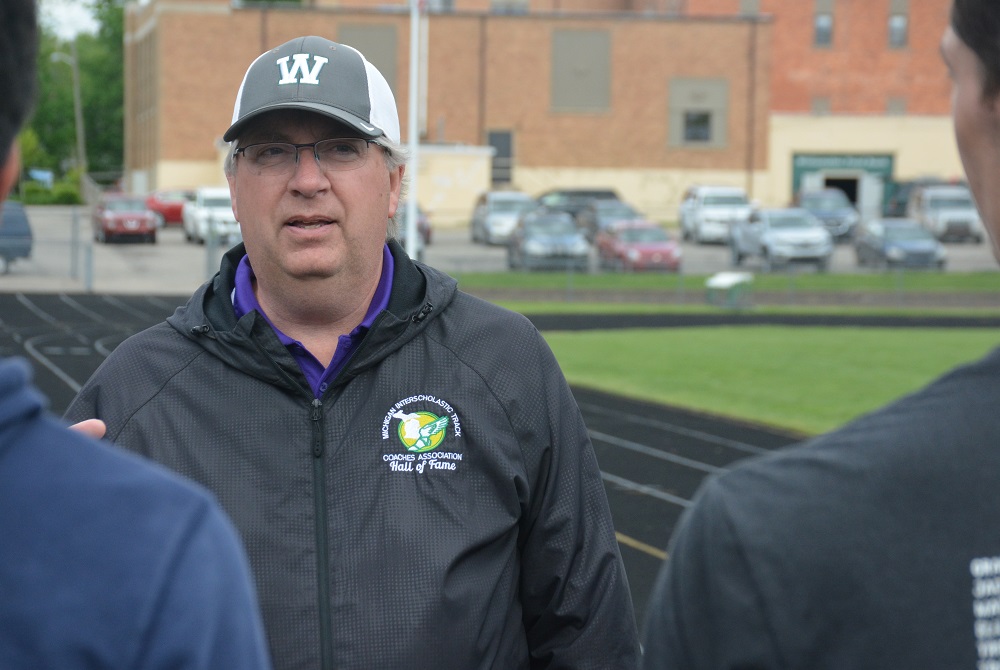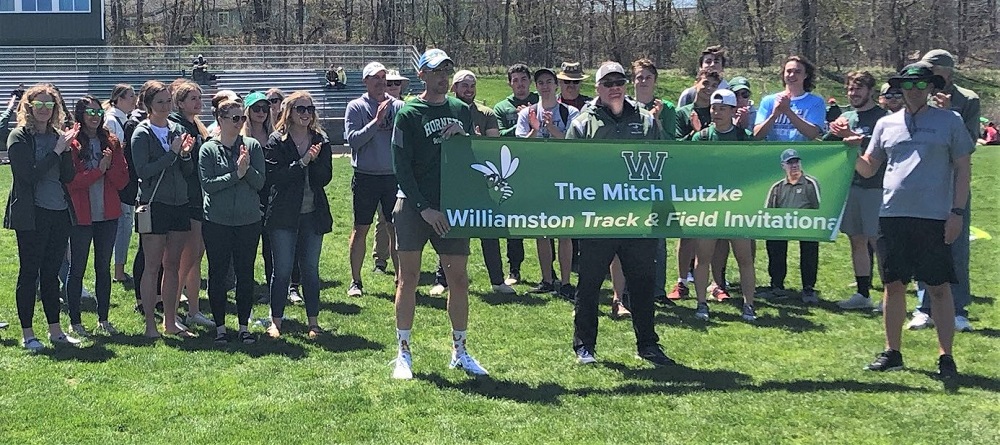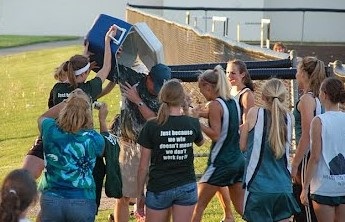
There's No Limiting Boyne City Vaulter
May 4, 2018
By Dennis Chase
Special for Second Half
BOYNE CITY – Anna Harmeling is a smart, multi-talented, grounded 18-year-old.
 Well, grounded except when she’s tracking her speed down the runway, then hurtling her 5-foot-5 frame into the air to clear a bar in the pole vault.
Well, grounded except when she’s tracking her speed down the runway, then hurtling her 5-foot-5 frame into the air to clear a bar in the pole vault.
It’s an event in which she’s become quite accomplished. In a meet last Thursday at Harbor Springs, the Boyne City senior broke her own school record three times, clearing 11-6, 11-9 and finally 12 feet.
Harmeling is now the fourth vaulter in the state, and the first in Lower Peninsula Division 3, to clear 12 feet this weather-abbreviated season, according to athletic.net.
“Going for four PRs in a day is tough – she almost had 12-4,” Ramblers pole vault coach Andy Bryant said. “It’s an emotional rollercoaster. You’re celebrating one jump, but then you have to quickly re-focus for the next.”
That breakout afternoon was a confidence builder for Harmeling, who admittedly has struggled adjusting to a bigger 13-foot pole. She went 11-1 a year ago to break Katie Martin’s school record, but then had trouble finishing jumps and exceeding that height, including during the indoor season, as she tried to transition to the new pole.
“I was stuck there for almost a year,” she said.
Then, the Ram Scram at Harbor Springs happened.
“She’s finally getting comfortable with the longer pole,” head coach Andy Place said. “We’re excited for her. It’s been an adjustment. You need a longer pole to go higher, but you have to adjust your steps, and when to bend the pole. There’s a technique to it.”
Even at Harbor Springs, Harmeling reverted to her old pole to clear 10-6.
“Then, (Bryant) said, ‘OK, you’re going back to the new pole,’” Anna’s mother Andrea said. “It just clicked for her after that.”
“I had to apologize to Anna afterwards,” Bryant said. “I didn’t celebrate that much when she went 11-6 and 11-9 because I knew she was going to make 12.
“I told her when she changed (poles) she had to be patient. The timing is different. It’s hard to jump from one pole to another. But I knew once she started to get it down, the heights would come - and it finally happened. It’s a lot of stress off her shoulders now. She knows she can do it. Now, it’s working on the technical things that college vaulters work on.”
Like form.
Harmeling said with better technique she could have cleared 12-4 that day.
“I had the height, but I need to work on tightening my form to keep pushing that record up,” she said.
How high can she jump? She doesn’t know.
“I don’t know what my limits are,” she said. “I don’t think I’ve reached my peak. There’s more to learn. And I’m going to keep trying until I hit those limits, which is hopefully never.”
 It’s been an interesting journey for the Stanford-bound Harmeling – and Bryant, who recruited her as a freshman.
It’s been an interesting journey for the Stanford-bound Harmeling – and Bryant, who recruited her as a freshman.
Since few athletes gravitate to pole vaulting, Bryant, a science teacher at the high school, looks for students who are athletic and coachable.
This was an exception: Harmeling was not an athlete.
But Bryant, who had her in class, saw potential.
“Physically, I probably wouldn’t have approached her,” he said. “She was a teeny little freshman who had never played sports. But I saw her determination in the classroom, how she attacked her academics. I thought let’s give this a try. She’s a clean slate. She has no bad habits (from playing other sports).”
Bryant, who has been coaching the sport 20-plus years, had to not only convince Anna, but her parents Mike and Andrea, too.
“We went to a parent-teacher conference and met with the science teacher,” Andrea recalled. “My husband and I are doctors, so we’re science people. We were excited about the conference. Andy Bryant was her science teacher. When we walked in he said, ‘Yeah, yeah, yeah, she’s good. She’s fine with science. Now, has she chosen a sport?’ My husband and I looked at him and said we’re not really sports people. I said we think of math as a sport.”
“That’s part of why Anna wanted to try it – to prove to us math wasn’t the only sport,” added Mike, laughing.
“(Bryant) said he thought she would be really good at pole vaulting. It sounded interesting, so we said, ‘Sure, why not, let her try.’”
Pole vaulting is not an easy event to learn. Anna quickly found that out.
Boyne City has a vault box in its gymnasium floor so vaulters can work on their craft during the offseason. Training sessions typically draw vaulters from across the region, who come to train with Bryant, a former vaulter at Central Michigan University.
It’s also a testing ground for new vaulters to see if they will like it before spring practice begins.
Harmeling, however, had research to do first.
“I had to look it up online and watch a video,” she acknowledged. “I didn’t understand the concept. That first day wasn’t good at all. I had no idea what I was doing. I was terrified trying my first jump. But, I thought, I can’t end it on a bad day. I, at least, have to do well enough before I quit.”
Well enough was good enough for Bryant.
“That first practice I ran her through some preliminary drills, and she just floored me,” he said. “I remember telling my wife I haven’t been this excited about a kid in a long time. She’s not only coachable, she’s smart.
“When you meet her, you can see that determination in her eyes. I could tell the first week of school (her freshman year). She is a kid who will find a way to get more out of an assignment, more out of a question, than you intended. You ask any teacher and they’ll say she challenges you in a good way. You put something in front of her and she’ll make it better. She’s always pushing that limit. That’s the quality I zeroed in on.”
Harmeling tackled pole vaulting like she does her classwork – with a vengeance. If she wasn’t practicing or working on plyometrics, she was in the weight room gaining strength.
“A lot of young athletes today want the quick hit,” Bryant said. “They want to be No. 1 with minimal work. It’s so refreshing to see a kid work her tail off to reach her goals. In season, out of season, she’s there. Now, she has a great chance to win at the state meet.”
Harmeling finished fourth at the MHSAA Lower Peninsula Division 3 Finals the last two years.
It took one year to make her way on to Bryant’s classroom wall, where he posts pictures of vaulters. He started with collegiate and world class vaulters, but he’s gradually replaced those with his own jumpers. The standards: Boys must jump at least 12 feet, girls 10.
“He told me, ‘If you jump high, I’ll put your picture up here, but you have to work hard,” Harmeling said.
Bryant started the board to attract interest in the discipline.
“Kids look at the wall and begin to understand what it’s all about,” he said. “Then they’ll say, ‘What’s the story here?’ That’s the hook. That’s when I say, ‘Want to try it?”
Today, Harmeling, a team leader, owns the school record that Martin, a 2004 MHSAA champion, had previously set at 11 feet.
“I thought that record would stand for a while, and it did,” Bryant said. “But as soon as I saw Anna as a freshman I remember telling her parents when they were trying to understand what pole vaulting was about that if Anna doesn’t challenge for a state title, there’s something wrong with my program. That’s the kind of kid she is. If you want to know how good your program is, you put Anna through it, and you’ll find out because this kid does everything you ask.”
And more.
Harmeling is also the lead runner on the 400 relay, and Tuesday in the Boyne City Invitational she tried the long jump for the first time after the pole vault was cancelled due to strong winds.
“She has never long jumped and had not practiced it,” Place said. “She used her pole vault approach … and won the event with a jump of 15-6, which makes her one of Boyne City’s top four jumpers ever. A 15-9 is the MHSAA state qualifying mark in Division 3, so after some practice we may have her jump again.”
Off the track, Harmeling, who carries a 4.048 grade points average, excels in other curriculars, too. She was the technical director for the Rambler Sports Network, which broadcasts football, basketball and volleyball games online. She was a section leader for the Rambler Rowdies, one of three finalists for the MHSAA Battle of the Fans VII championship. She was a state champion in a DECA business competition that qualified her for the international career development conference. And she plays stand-up bass in the family band that performs around the area.
“That’s kind of who she is,” Andrea said. “She’s not afraid to try new things – and when she does she goes all out. It’s been fun to watch. We would not have predicted any of these things for her when she started high school. She starts them, loves them and she’s good at them.”
That’s what happened when she needed to pick up some arts credits and came across a TV production class.
Bryant is a broadcaster during basketball season and works closely with Harmeling.
 “She sits in the truck with all the TVs and camera angles (usually four cameras) coming into that feed, and she is the one picking out the camera shot, talking in my ear when to go to replay, when to go to commercial. She’s coaching me.
“She sits in the truck with all the TVs and camera angles (usually four cameras) coming into that feed, and she is the one picking out the camera shot, talking in my ear when to go to replay, when to go to commercial. She’s coaching me.
“I told her teacher, if you take her, she’ll be running this thing in a year. And she was.”
“I loved it,” Harmeling said. “I’m still part of the program now. I’m helping edit a final senior year video. It’s such an interesting platform to be part of because it’s so high-paced. I got to work with great people. It’s so interesting to learn the people side – figure out what the viewer wants to see, how things should be visually organized – and the technical side of programming. It’s like a puzzle.’
As for the family band, Mike is a banjo player in the Horton Creek Bluegrass Band. He also plays in the family band with Anna (stand-up bass), Katie (fiddle), Megan (guitar) and Ben (guitar).
Katie, a junior, and Megan, a freshman, play on the Ramblers soccer team. Ben, a seventh-grader, also plays soccer.
Anna, after posting a 1550 out of 1600 on the SAT, is off to Stanford in the fall. She also was accepted at Harvard. The Harmelings visited Stanford in February.
“I loved the people, the campus, the academics,” Anna said. “It was amazing. It became my dream school.”
Plus, it had something Harvard couldn’t offer in the winter – warm weather.
Harmeling has touched base with the Stanford track coaches about the possibility of walking on. That didn’t seem too promising until she cleared 12 feet last week.
“They told her to keep them posted so when she popped 12 one of the first things she said is, ‘I’ve got to send the Stanford coach an e-mail,’” Bryant said. “I don’t know if there’s a coach in the country that wouldn’t take a 12-foot walk-on.”
If it happens, it would be awesome, Harmeling said. If not, academics will keep her busy and she’s interested in contacting the school’s broadcasting program, too.
“I would love to work in sports broadcasting,” she said.
She’s also interested in international business.
There’s so much in the air right now, including how high she can go in the pole vault.
“Fingers crossed at this point,” she said. “I’m just trying to have fun and see how high I can go and not put any number in my head I have to reach.”
 Dennis Chase worked 32 years as a sportswriter at the Traverse City Record-Eagle, including as sports editor from 2000-14. He can be reached at [email protected] with story ideas for Manistee, Wexford, Missaukee, Roscommon, Ogemaw, Iosco, Alcona, Oscoda, Crawford, Kalkaska, Grand Traverse, Benzie, Leelanau, Antrim, Otsego, Montmorency, Alpena, Presque Isle, Cheboygan, Charlevoix and Emmet counties.
Dennis Chase worked 32 years as a sportswriter at the Traverse City Record-Eagle, including as sports editor from 2000-14. He can be reached at [email protected] with story ideas for Manistee, Wexford, Missaukee, Roscommon, Ogemaw, Iosco, Alcona, Oscoda, Crawford, Kalkaska, Grand Traverse, Benzie, Leelanau, Antrim, Otsego, Montmorency, Alpena, Presque Isle, Cheboygan, Charlevoix and Emmet counties.
PHOTOS: (Top) Boyne City’s Anna Harmeling prepares to begin her pole vault approach. (Middle) Harmeling clears the bar during a meet. (Below) Harmeling points to her spot on coach Andy Bryant’s board of honored pole vaulters. (Photos courtesy of Anna Harmeling.)
VIDEO: Boyne City’s Anna Harmeling clears 12 feet for the first time during a meet April 26 at Harbor Springs. (Video courtesy of Anna Harmeling.)

Self-Taught Lutzke Leaving Williamston with Decades of Memorable Lessons
By
Geoff Kimmerly
MHSAA.com senior editor
June 1, 2022
WILLIAMSTON – If it were possible to string together all of the moments that made Mitch Lutzke into a Hall of Fame high school track & field coach, the first half of the video would look like a one-man pentathlon.
 At most, the now-longtime Williamston leader brought into coaching a season of mostly-junior varsity cross country experience as a student at Albion High, and some additional knowledge gleaned from marrying a college All-American runner.
At most, the now-longtime Williamston leader brought into coaching a season of mostly-junior varsity cross country experience as a student at Albion High, and some additional knowledge gleaned from marrying a college All-American runner.
He also didn’t have the internet back then to speed up the learning curve. But he had books to show him technique, and coaching clinics where he’d learn more. The skills he was using as a morning radio news reporter surely helped him digest information and pass it on to his pupils. And he had an open track facility, where he’d go when no one else was around and try to teach himself all of the events so he could better serve as his wife Karen’s assistant as she was coaching middle school kids in Illinois before she herself would go on to lead college programs for most of the last three decades.
“I just wanted to make my wife happy and said, ‘I'll coach middle school track,’ which I didn't want to do. And I almost tried to quit. I'm like, I don't want to do this. I don't even know what I'm doing. And she's like, ‘No, you could just learn,’” Mitch Lutzke recalled last week.
“I tell people I’d do this, and they think I’m making this up. I’d stand there with a book and say, ‘OK,’ and I would go do it, and like, ‘OK, that’s how you do it right.’ So I decided, but nobody needs to know when they do it right – they need to know when they do it wrong. So I would take a book and look at discus. I said, ‘OK, I’m throwing it straight. How do I throw it left? So I’ve changed my feet. And if I step in a bucket, I’m going left. Or if I don’t block out, or if I do this … so I’d write down all these things to fix the kids. I did trial and error; what do I do if it goes too high in shot? OK, what did I do with my thumb? So I wrote a bunch of little notes down.”
His experiences, especially over the last 32 years leading the Hornets girls and now both the girls and boys programs, could fill a book – and he’s written a few of those too, on other subjects that have interested the also big-time sports fan and local historian.
Lutzke has begun the final week of a coaching career that’s seen him build upon one of the state’s most consistently-strong track & field programs and make it his own. Since taking over the Hornets girls team in 1993 and then adding the boys team in 2014, Lutzke has amassed 250 meet wins, 16 girls league championships and five conference titles with the boys, 12 Regional championships, eight top-10 MHSAA Finals finishes and nine Michigan Interscholastic Track Coaches Association team state titles. In 2020, he was named to the MITCA Hall of Fame.
 That’s a whale of a list for someone whose “gift for gab” had him headed initially down a path aspiring to be the next Dan Rather. He had earned accolades and opportunities to continue in broadcasting, but found himself instead taking a path back to school to become a teacher, into the classroom and onto the track and sideline, with his communication skills and knowledge no doubt pouring into the multiple books and other pieces he’s written on baseball and local history, the classes he’s taught as a popular social studies and television broadcast teacher at Williamston and the years serving most recently as the public address announcer at many Hornets events.
That’s a whale of a list for someone whose “gift for gab” had him headed initially down a path aspiring to be the next Dan Rather. He had earned accolades and opportunities to continue in broadcasting, but found himself instead taking a path back to school to become a teacher, into the classroom and onto the track and sideline, with his communication skills and knowledge no doubt pouring into the multiple books and other pieces he’s written on baseball and local history, the classes he’s taught as a popular social studies and television broadcast teacher at Williamston and the years serving most recently as the public address announcer at many Hornets events.
“The thing about Mitch is he’s not one dimensional, even in coaching – he can coach many different events. He has many different interests outside of track & field. And when he does something, he does it 100 percent,” Karen Lutzke said. “Even when he started coaching a long, long time ago with me … he just kept learning. He likes working with kids. He enjoys that and watching them get better, whether it’s a guy who’s a 30-foot shot putter or a 45-foot shot putter, or any event. It’s not how far they throw, it’s are they doing the best they can?
“He just likes the kids, and being around them. I think it’s going to be harder than he thinks, retiring – because the kids are what make coaching fun. Being around the kids and watching them have success, and he’s had a lot of success.”
‘Expectation of Excellence’
Williamston has had its fair share of MHSAA Finals individual placers over the years, with the best of those eight top-10 team finishes under Lutzke coming in 2007 when the girls placed fourth in Lower Peninsula Division 3.
The MHSAA Finals team championships are determined by the success of individuals who qualify from Regionals, which could be just a handful. Williamston has shined even brighter, however, at the MITCA Team Finals, where the competition pits full teams against each other and the Hornets’ talent and depth across all events frequently has stood out.
Longtime and similarly-legendary coach Paul Nilsson led both Williamston track & field programs from the 1970s into the 1990s. Lutzke joined him as an assistant for both in 1991 – following Karen after she’d been hired to coach women’s cross country and assist with track & field at Michigan State. In 1993, Lutzke took over the Hornets girls track & field program.
Known now for success in a variety of sports, Williamston during the first decade of the 2000s was most consistently revered for that MHSAA championship-caliber track & field success – and on the girls side, that superiority was rooted in part in the daily grind of January and February workouts often in the school’s hallways or later on an inside track that circles the gym.
 Lutzke’s “Winter Warriors” got a T-shirt if they trained a certain number of days during the offseason. But that was just a small bonus for showing up. The memorable pay offs came three and four months later in league titles, Regional successes, MITCA titles and MHSAA Finals achievements.
Lutzke’s “Winter Warriors” got a T-shirt if they trained a certain number of days during the offseason. But that was just a small bonus for showing up. The memorable pay offs came three and four months later in league titles, Regional successes, MITCA titles and MHSAA Finals achievements.
“I’ve never quite had another experience in my lifetime that demonstrated that as much to me. Now I know moving forward in my life that if I expect to be great at something, or I expect to achieve results, I have to put the work in myself,” said 2019 graduate Jessica Robach, who that spring helped Williamston finish 10th at the MHSAA LPD2 Final running on a championship relay and placing third in long jump and as part of another relay. “It’s really kind of a personal integrity and motivation thing that draws a direct parallel to my career in track and to when I really decided to push myself to be great – you put in the hours of work, and then it finally happens.
“That’s just something Mitch always reiterated to us: That you can have all the natural talent in the world, but a person who works hard is going to get to where they want to be.”
Robach began attending Williamston as a freshman, and didn’t feel entirely comfortable with her new school until track season came – when “everything fell together.”
That “expectation of excellence” wasn’t just about competing athletically, but striving to be a good person. The camaraderie he established, the way he made sure knowledge was passed down from the oldest athletes to the youngest, and again, the emphasis on work ethic overcoming talent, have continued to stick with Robach as she’s gone on to study at Western Michigan.
“Mitch does things the right way. He believes in fair play, hard work, and preparation. He keeps an even keel with athletes – he doesn't get overly hyped when the team is successful or overly critical when the team struggles,” said assistant Ray Herek, who has coached with Lutzke since 2002 and taught with him since 2000. “I have learned a ton from watching him coach. He does an excellent job of knowing how to approach each athlete – he reads people very well. He seems to know what makes each person tick, and finds the right words or coaching tips to help each athlete excel.”
A decade before Robach, Leanne Selinger was learning the same lessons. The team’s leadership award is named after her, and after running on two Finals-placing relays as a senior in 2010 she actually went on to serve as an assistant coach on Lutzke’s staff over the next four seasons while at college.
These days she’s working in supply chain management – a higher-pressure-than-usual field lately because of headline-making materials shortages in a number of industries. But what she learned from Lutzke about being flexible and prepared for the unexpected – in a track meet, maybe a scratch or an injury – while trying to lead people from different subgroups (sprinters, distance runners, jumpers, etc.) toward a common goal are among lessons she continues to keep front of mind.
“Even in my professional career now, I get a lot of feedback that I am not afraid to roll up my sleeves, get dirty,” Selinger said. “And I think that comes from some of my track history with Coach Lutzke and being able to go out, let’s go out and get the job done. If we have to do X-Y-Z, let’s go do it.”

Signing Off
After the couple moved from Illinois, Mitch Lutzke taught in Lansing for five years while coaching at Williamston, then came to Williamston to teach as well. He added coaching in basketball and cross country at the middle school and subvarsity levels, and immersed himself in the family’s new community. Karen Lutzke is now in her second tenure at Olivet College, coaching the women’s and men’s cross country and track & field teams, and the couple has sent three children through Williamston schools with two going on to run at the college level.
Mitch let the decision to retire sink in over this school year – he’s retiring from teaching as well – and eventually he had one more major objective to complete this spring. And he accomplished it.
Williamston track & field wasn’t alone trying to dodge the wrenches thrown its way by COVID-19. But the effects certainly were noticeable.
When the 2020 spring season was suspended (to be ultimately canceled) late that March, Williamston’s teams had practiced four days – with 125 students (nearly 20 percent of the entire student body) signed up and hopes high with lots of talent and experience returning. When spring sports returned a year ago, Williamston was down to 49 athletes in the program – including only 16 girls – with that missing year of older athletes recruiting and mentoring the younger ones striking a massive blow.
 This spring, numbers didn’t return all the way to pre-COVID levels. But 90 athletes came out to put the program on solid footing for this season and whoever comes next.
This spring, numbers didn’t return all the way to pre-COVID levels. But 90 athletes came out to put the program on solid footing for this season and whoever comes next.
“I've been amazed this year how many coaches have approached Mitch with words of appreciation and admiration for the job he has done at Williamston,” Herek said. “Anybody that has coached track and field knows that it is so hard getting kids outside in the spring when it is 40 degrees outside. It is difficult to know how to coach all of the events. It is difficult to know how to reach each athlete – there are so many different types of students that go out for track. But Mitch is as good as it gets.”
He’ll pour his energies into other things. He’s going to do some announcing of Olivet College events. He wants to write more. He’d like to visit baseball spring training for the first time. “Whatever he’s involved, in he’s very passionate about and gets things done,” Karen Lutzke said. “Maybe we’ll have a very clean house (and) the lawn will look wonderful after this.”
Although Williamston’s boys team won’t send anyone to the MHSAA Finals this weekend for the first time in a number of seasons, Mitch Lutzke will bring five athletes to Saturday’s Lower Peninsula Division 2 championship meet at Ada Forest Hills Eastern. They will combine to run two relays, in two more individual races and participate in one field event.
Next year, he’ll cheer from the stands, maybe help move hurdles or clerk a meet if needed. Williamston has renamed its annual meet the Mitch Lutzke Williamston Track & Field Invitational, after all, and the namesake can’t be a no show.
“I say at the end of every year, if you've got more negatives than positives in what you did in track this year, then don't come out (next year). Because we're not changing. This is what we do,” Lutzke said. “I always tell the kids, I want you to support the program of track & field in the community you grow up in or you move to, that you put your kids in track & field because you thought it was a positive experience because of what you went through here in the program, and you just give back.”
 Geoff Kimmerly joined the MHSAA as its Media & Content Coordinator in Sept. 2011 after 12 years as Prep Sports Editor of the Lansing State Journal. He has served as Editor of Second Half since its creation in January 2012, and MHSAA Communications Director since January 2021. Contact him at [email protected] with story ideas for the Barry, Eaton, Ingham, Livingston, Ionia, Clinton, Shiawassee, Gratiot, Isabella, Clare and Montcalm counties.
Geoff Kimmerly joined the MHSAA as its Media & Content Coordinator in Sept. 2011 after 12 years as Prep Sports Editor of the Lansing State Journal. He has served as Editor of Second Half since its creation in January 2012, and MHSAA Communications Director since January 2021. Contact him at [email protected] with story ideas for the Barry, Eaton, Ingham, Livingston, Ionia, Clinton, Shiawassee, Gratiot, Isabella, Clare and Montcalm counties.
PHOTOS (Top) Williamston coach Mitch Lutzke talks things over with his boys team captains last week. (2) Lutzke stands with, from left, Diana Eidt, Cassidy Metzer, Mallory Metzer and Elizabeth Dutcher – who ran on school record-setting 400 and 800 relays in 2011. (3) Lutzke is recognized earlier this spring as Williamston’s annual meet is named after him. (4) Lutzke and assistant Ray Herek (kneeling) confer with their girls team. (5) The 2009 team dumps a cooler over Lutzke’s head to celebrate a Capital Area Activities Conference league meet championship. (Last week’s photos by Geoff Kimmerly; others courtesy of Williamston track & field and athletic department.)

